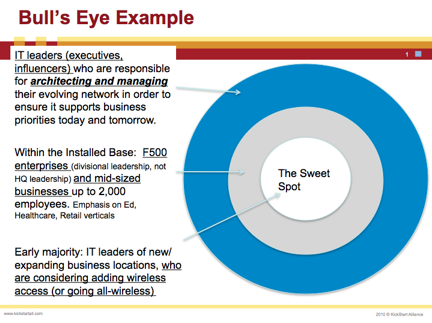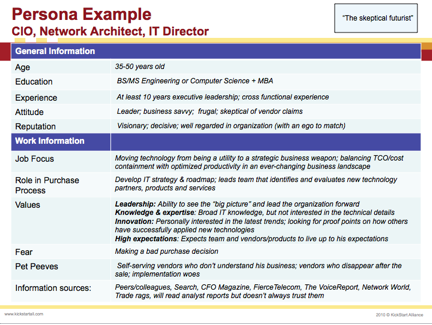We are victims of our own desire to sell to anyone and everyone. Collectively speaking, in our race to help sales make quarterly numbers, marketing teams fall into the trap of casting as wide a net as possible for fear of leaving out a potential audience segment.
Unfortunately, this approach of broad inclusiveness leads to a mish-mash of messaging and an ineffective marketing campaign that actually extends the sales cycle. Here are 3 practical steps marketers are taking today to hone their go-to-market strategies and shorten the sales cycle.
Step 1: Focus, focus, focus
The task of market segmentation is like aiming for the bull’s eye. Where is the sweet spot: those key folks most likely to buy your product?
Traditional market segmentation brings to mind an academic, time-consuming, and costly process. It doesn’t have to be. I’ve found that key people within any company have knowledge in their head that, if shared, would greatly accelerate any segmentation process.
Template: A simple bull’s eye template is an excellent way to guide a cross-functional team discussion.

We need more focus. While capturing some dimensions of the broadest segmentation description (outer circle), ask the team to add a few more adjectives and distinguishing characteristics about the prospect and their environment. Do these folks know who we are? This is represented in the middle layer. But, we’re not yet done.
Still, we need more focus. Are they already aware of solution alternatives, or do they need to be educated? What are their preferences? Where are they in their buying process?
Combined, the three layers of the bull’s eye template help marketers hone their messaging to capture the set of prospects most likely to buy now.
Step 2: Paint a picture of your target persona
Market segmentation, however, is not enough. Buyers are a skeptical bunch that doesn’t like to be sold to. You need to empathize with your buyer personas. And you can only do that by knowing what makes these folks tick. That’s where the persona template comes in.
Template: In general, the marketing team (as a collective) has a lot of knowledge and perspective about the target buyers. Unfortunately, this information is distributed in pieces and not written down in a format that can be easily referenced and shared. It’s easy to collect a lot of data, but it’s another matter to boil it down into a single, meaningful slide.

“Historically, we’ve been selling too low into the organization. We need to aim higher, and this is the right target for us.”
“I’ve been selling to this group for 5 years and I’ve never seen the persona written down before. You got it right. This is exactly who I’m meeting with this afternoon”
Talk about a confidence boost to the marketing team.
Step 3: Adopt the 80/20 rule for proactive/reactive marketing spend
There is not enough time, money, or energy to be all things to all people. Therefore, marketers need to determine where the best ROI can be found. While we will all gladly accept money from anyone who wants to purchase our products, where is the easiest target segment to capture first? It is assured that if marketers identify and win a beachhead segment, there will be a halo effect to attract a wider audience.
An example: A company was caught up in the vicious cycle of continuously marketing to everyone, with no distinction between new leads and their prospect database. They treated all prospects the same. In search for a more effective approach, they worked cross-functionally to identify and prioritize two target audience personas that represented entry points for engaging the most-likely-to-buy prospects. Marketing efforts were then split between a new proactive lead generation outreach to these personas with 80% of the marketing budget being applied to developing a meaningful marketing blueprint to engage these folks. Meanwhile, 20% of the budget was saved to allow for flexibility to address reactive market opportunities.
Putting it all together
This heightened focus resulted to crisper, more relevant messaging. Response levels increased, and the sales team was rewarded with more, higher quality leads in less time.
Deciding to prioritize and focus on a sub-segment is risky. After all, what if you guess wrong? However, think about it this way: if you guess correctly, then your marketing ROI is guaranteed to be greatly improved. If you do guess wrong, then you quickly find out what not to do and you can move on to the next segment with confidence. Either way, you win by avoiding wasting precious time and money and unnecessarily lengthening the sales cycle.
Mike Gospe leads KickStart Alliance's marketing operations practice where he conducts team-based "practical application working sessions" to improve the effectiveness of lead generation campaigns and product launches. His fun, practical approach and roll-up-his-sleeves attitude energizes teams, helping them to get "real work done" while guiding them to the next level of excellence. Mike is the author of the book and blog, Marketing Campaign Development, and his methodology is being used by San Francisco State University's College of Extended Learning course: "Essentials of Integrated Marketing."





